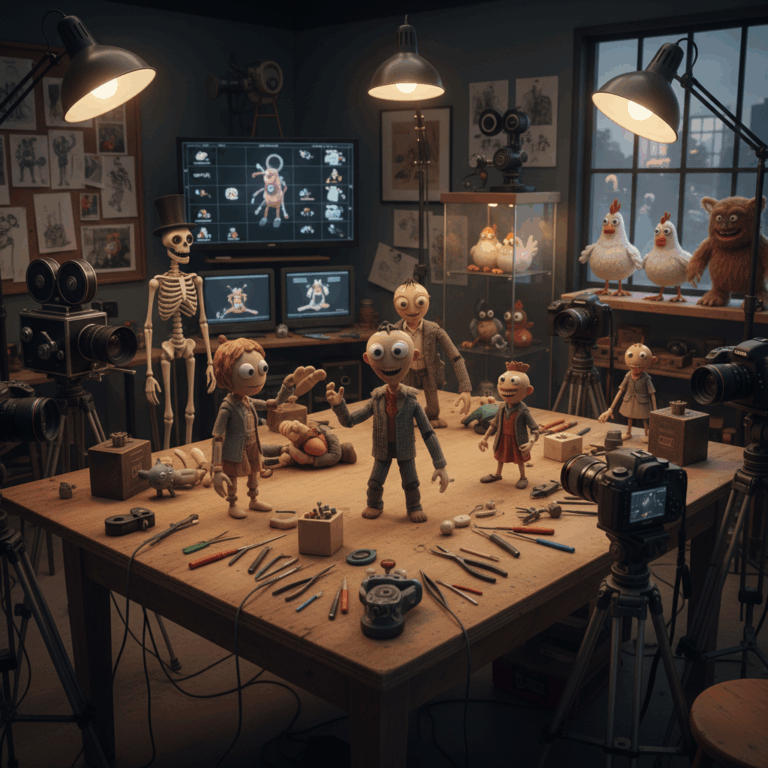Techniques and characteristics of stop-motion animation
Stop-motion animation is a handcrafted technique that brings inanimate objects to life through the sequential capture of images. Each movement is created by slightly altering the elements between each photograph.
Since the late 19th century, this technique has evolved considerably, establishing itself as a unique language that combines art and film. It is valued for its expressiveness and creativity.
Foundations and historical evolution
Stop-motion animation is based on the principle of animating objects frame by frame to create the illusion of movement. Its origins date back to the 19th century, making it a pioneer in visual effects.
Over time, it has been perfected with technical and artistic advances, maintaining its artisanal essence and adding technological tools that expand its narrative possibilities.
Directors and historical studies such as Jiří Trnka and Czechoslovak Studies contributed to its development with a poetic and subtle approach, which influenced future generations.
Technical variations and materials used
Stop-motion animation uses various techniques, such as clay modeling, or pixilation, which animates live actors. These variations enrich the visual language.
Common materials include clay models, cut paper, fabric, and even LEGO bricks, expanding creativity through different styles and textures.
The integration of technologies such as 3D printing allows for complex facial details and elaborate sets, improving the expressiveness and quality of the productions.
Leading international studios in stop-motion
Stop-motion animation has been propelled forward by international studios that have taken the technique to new levels of quality and expressiveness. These studios are known for their innovation and distinctive style.
Through their works, they have managed to consolidate stop-motion as an artistic medium capable of exciting and surprising, combining artisanal tradition with advanced technology.
Aardman Animations and plasticine
Aardman Animations, originally from the United Kingdom, is famous for its mastery of claymation, a technique that uses plasticine to create detailed and expressive characters and settings.
His productions, such as Wallace & Gromit and Chicken Run, stand out for their visual humor and precision in animation, achieving an immediate connection with a global audience.
This studio has perfected artisanal maneuvers that allow for natural and expressive movements, becoming a world reference for traditional stop-motion.
Laika and technological integration
Laika, based in the United States, combines traditional animation with technological innovations such as 3D printing to enrich facial details and expressions of its puppets.
Films like Coraline and Kubo and the Two Strings showcase their ability to integrate technology into the artisanal process, creating stunning and complex visual worlds.
This fusion between technology and art allows them to innovate in narrative language, while maintaining the artisanal essence that characterizes stop-motion.
Czechoslovak Studies and Jiří Trnka
Czechoslovak Studios and director Jiří Trnka were pioneers who defined stop-motion as a poetic and artistic form, influencing generations of animators afterward.
Trnka stood out for his delicate craftsmanship and visual sensitivity, achieving a unique style that marked European animated cinema during the 20th century.
His legacy remains relevant, demonstrating the cultural and expressive richness of stop-motion as a global artistic language.
Emblematic works and narrative styles
Classic and contemporary stop-motion works demonstrate the narrative richness and stylistic diversity that this technique allows, capturing the imagination of different audiences.
The narrative styles range from dark and gothic to colorful and detailed universes, demonstrating the versatility of stop-motion to tell unique stories.
Classics like The Nightmare Before Christmas
The Nightmare Before ChristmasDirected by Henry Selick and produced by Tim Burton, it is an icon of stop-motion for its gothic aesthetic and meticulous design.
The film combines dark elements with a magical and musical touch, showing how stop-motion can create immersive and emotional atmospheres.
Her narrative explores themes of identity and self-discovery, exemplifying the technique's ability to convey complex emotions.
Contemporary productions by Wes Anderson
Wes Anderson has innovated stop-motion with films like Fantastic Mr. Fox and Isle of Dogsusing the technique to build detailed and aesthetically refined universes.
His style is characterized by symmetries, flat colors, and characters with precise gestures, which enrich the narratives with touches of humor and depth.
These productions stand out for their careful artistic direction, merging the craftsmanship of stop-motion with a modern and sophisticated cinematic approach.
Creative process and professionalization
The creative process in stop-motion animation requires meticulous planning, from storyboarding to the handcrafted construction of each element. This care ensures that every movement is fluid and expressive.
Handcrafted production is fundamental to this art, involving the detailed creation of puppets, sets, and props, as well as frame-by-frame capture, which demands patience and precision.
Planning and artisanal production
Before animation, a storyboard is designed that outlines each scene and movement. This allows for clear planning of the sequence and timing to achieve a coherent and effective narrative.
The handcrafted production includes modeling characters, preparing sets and accessories, all made by hand to ensure authenticity and visual quality, reflecting the original spirit of stop-motion.
Image capture is a laborious process where every small change in pose or expression is carefully photographed to create a continuous and realistic movement.
Multidisciplinary collaboration in complex projects
Contemporary stop-motion projects integrate professionals from diverse areas: animators, sculptors, designers, and post-production technicians work together to achieve the artistic vision.
This multidisciplinary collaboration is key to managing technical and creative complexity, allowing for innovation and maintaining quality in the face of the growing demand for original content.
The synergies between skills in modeling, lighting, editing, and visual effects enrich the production and allow each project to have a unique and professional finish.






